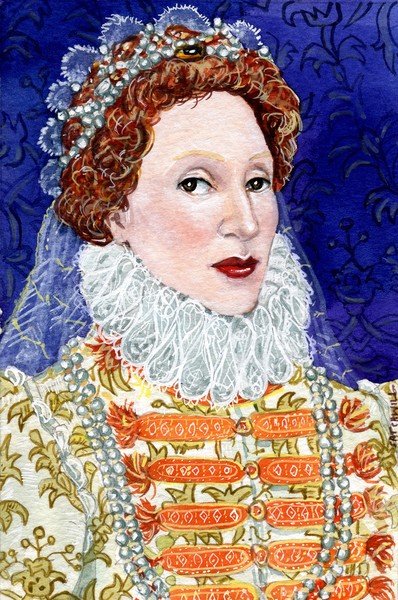- Mark Satchwill
- View Portfolio
- Image 94 of 109
- Added 20 Jul 2007
- 606 Views
- 11 Comments
- Share This Image On...

4 x 6 inches, watercolor and gouache, July 2007 Elizabeth was crowned Queen in January 1559, beginning a reign that was to last 44 years and be considered a "Golden Age". She was aided by Sir William Cecil, who was to become her chief advisor until the 1590's. She had a lot to prove - not just as a woman. Her sister Mary's reign had left the country in debt and religious instability. She was also considered by some to be illegitimate. Generally however she was popular and well thought of, considered intelligent and learned. She set about tackling religion. The Act of Uniformity was passed, outlawing Catholic communion and stating that the Protestant Book Of Common Prayer was to be used for all church services. Then the Act of Supremacy was passed, confirming Elizabeth as Supreme Governor of the Church of England and giving her the power to remove from office anyone who refused to recognise this. One long and hard battle that Elizabeth fought with her councillors was over the question of marriage and the succession. As a woman Elizabeth was expected to marry and provide an heir. However, though she entertained the idea on several occasions, using her availability as a bargaining tool, it is doubtful she ever seriously considered marriage to anyone. She was linked for many years to Robert Dudley, her favourite. Scandal was narrowly averted when Dudleys wife was found dead t the bottom of a staircase in 1560. Many believed she had been murdered by Dudley to free himself to marry the Queen. It is doubtful Eizabeth ever seriously considered marriage to Dudley and later offered him to Mary Queen of Scots as a husband. While there are many reasons put forward as to why Elizabeth refused to marry, such as deformity or fear caused by the memory of her mother's execution, the most likely is simply that she did not want to have to share her power with a husband. She also remembered the hostility aroused when Mary had married a foreigner. Also, as the only Protestant Monarch in Europe she could not seriously entertain marrying a Catholic. Elizabeth became seriously ill with smallpox in 1563 and came close to death. The situation highlighted the need for a successor to be named but again Elizabeth refused to do so for fear of encouraging plots and rebellions. In fact religion was the force behind the Northern Rebellion of 1569 and the Ridolfi Plot of 1571. While both failed, the former led to the Queens change of policy of from one of toleration to one of persecution and to harden her Protestant line. The Ridolfi Plot involved Philip II of Spain, her sister Mary's husband and was a result of having her cousin and rival Mary Queen of Scots on her soil, having recently been chased out of Scotland. Mary was another problem she would have more trouble with as her reign progressed. This painting is based on the Darnley portrait, painted when Elizabeth was in her early 40's.
5 of 11 Comments Show All 11 Comments
Cristina Andrisan 15 Jan 2009
You are a real great talented artist!Beautifully done!Rebecca Wadle 23 Jul 2007
Well done!!Mark Saxton 22 Jul 2007
Beautiful piece , Mark. Fantastic detail.Laura Smith 21 Jul 2007
Wow! Just Wow! All the detail! What a lovely painting!Renata Cavanaugh 21 Jul 2007
Fantastic watercolors work Mark. Beautiful detail!